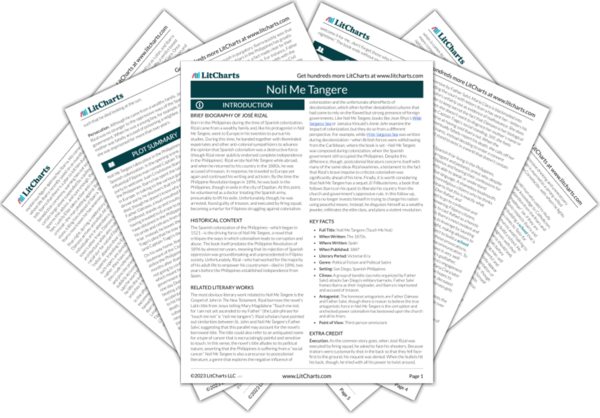Welcome to the LitCharts study guide on José Rizal's Noli Me Tangere. Created by the original team behind SparkNotes, LitCharts are the world's best literature guides.
Noli Me Tangere: Introduction
Noli Me Tangere: Plot Summary
Noli Me Tangere: Detailed Summary & Analysis
Noli Me Tangere: Themes
Noli Me Tangere: Quotes
Noli Me Tangere: Characters
Noli Me Tangere: Symbols
Noli Me Tangere: Literary Devices
Noli Me Tangere: Theme Wheel
Brief Biography of José Rizal

Historical Context of Noli Me Tangere
Other Books Related to Noli Me Tangere
- Full Title: Noli Me Tangere (Touch Me Not)
- When Written: The 1870s.
- Where Written: Spain
- When Published: 1887
- Literary Period: Victorian Era
- Genre: Political Fiction and Political Satire
- Setting: San Diego, Spanish Philippines
- Climax: A group of bandits (secretly organized by Father Salví) attacks San Diego’s military barracks. Father Salví frames Ibarra as their ringleader, and Ibarra is imprisoned and accused of treason.
- Antagonist: The foremost antagonists are Father Dámaso and Father Salví, though there is reason to believe the true antagonistic force in Noli Me Tangere is the corruption and unchecked power colonialism has bestowed upon the church and all its friars.
- Point of View: Third-person omniscient
Extra Credit for Noli Me Tangere
Execution. As the common story goes, when José Rizal was executed by firing squad, he asked to face his shooters. Because traitors were customarily shot in the back so that they fell face-first to the ground, his request was denied. When the bullets hit his back, though, he tried with all his power to twist around, such that he died looking at the sun.
Persecution. Although he came from a wealthy family, José Rizal was no stranger to the oppressive ways of the Spanish government. When he was a young boy, for example, his mother was falsely accused of poisoning a neighbor. As a result, she was imprisoned for more than two years.







